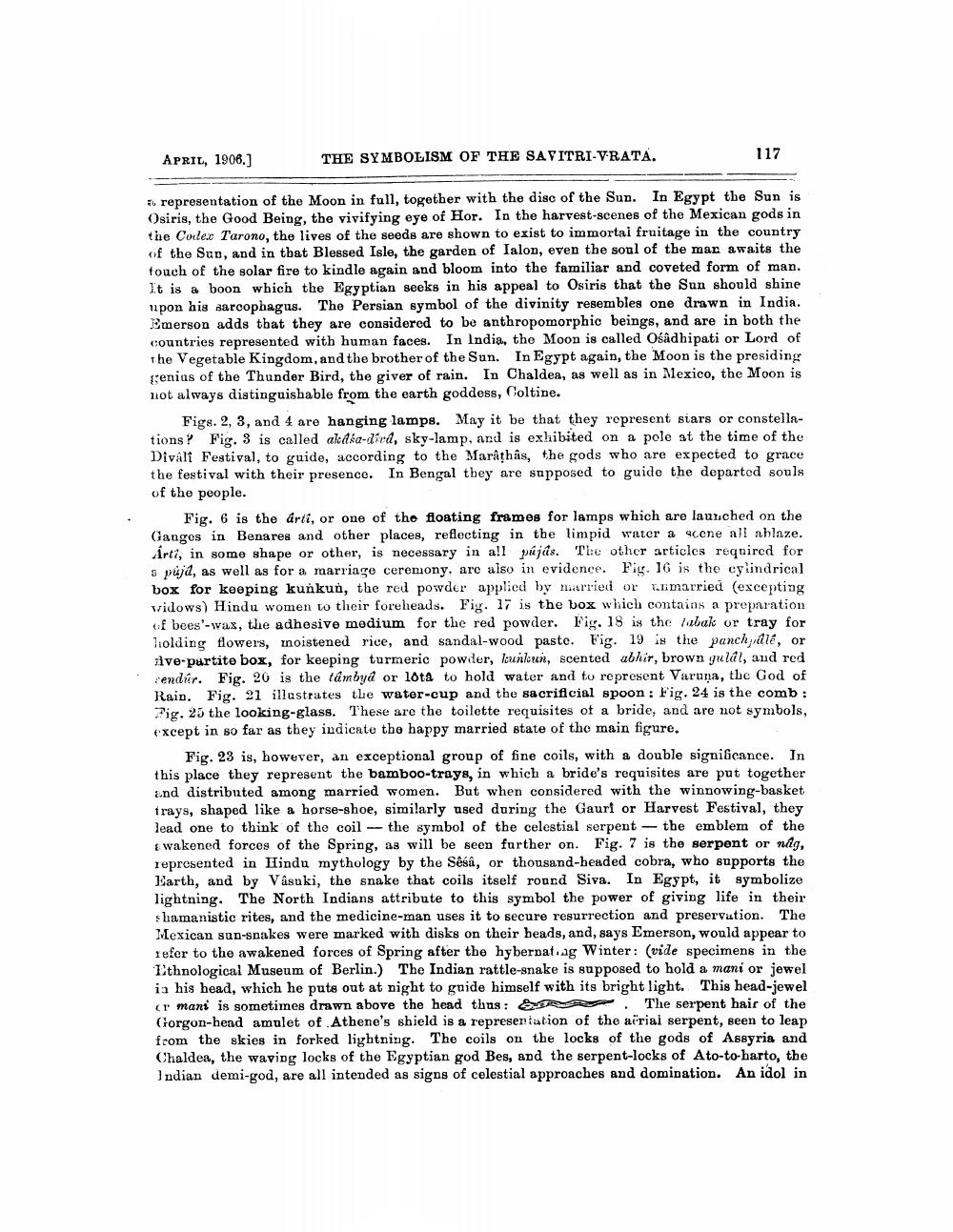________________
APRIL, 1906.]
THE SYMBOLISM OF THE SAVITRI-VRATA.
117
a representation of the Moon in full, together with the disc of the Sun. In Egypt the Sun is Osiris, the Good Being, the vivifying eye of Hor. In the harvest-scenes of the Mexican gods in the Codex Tarono, the lives of the seeds are shown to exist to immortal fruitage in the country of the Sun, and in that Blessed Isle, the garden of Ialon, even the soul of the mar awaits the touch of the solar fire to kindle again and bloom into the familiar and coveted form of man. It is a boon which the Egyptian seeks in his appeal to Osiris that the Sun should shine upon his sarcophagus. The Persian symbol of the divinity resembles one drawn in India. Emerson adds that they are considered to be anthropomorphic beings, and are in both the countries represented with human faces. In India, the Moon is called Ośadhipati or Lord of The Vegetable Kingdom, and the brother of the Sun. In Egypt again, the Moon is the presiding genius of the Thunder Bird, the giver of rain. In Chaldea, as well as in Mexico, the Moon is not always distinguishable from the earth goddess, Coltine.
Figs. 2, 3, and 4 are hanging lamps. May it be that they represent siars or constellations? Fig. 3 is called akasa-dird, sky-lamp, and is exhibited on a pole at the time of the Divali Festival, to guide, according to the Marâțhâs, the gods who are expected to grace the festival with their presence. In Bengal they are supposed to guide the departed souls of the people.
Fig. 6 is the arti, or one of the floating frames for lamps which are launched on the Ganges in Benares and other places, reflecting in the limpid water a scene all ablaze.
Arti, in some shape or other, is necessary in all pújás. The other articles required for s pújd, as well as for a marriage ceremony, are also in evidence. Fig. 16 is the cylindrical box for keeping kunkun, the red powder applied by married or unmarried (excepting widows) Hindu women to their foreheads. Fig. 17 is the box which contains a preparation of beeswax, the adhosive medium for the red powder. Fig. 18 in the labak or tray for Holding flowers, inoistened rice, and sandal-wood paste. Fig. 19 in the panch, die, or sive-partite box, for keeping turmeric powder, Tunkur, scented abhir, brown gulal, and red
endir. Fig. 20 is the lambyd or lota to hold water and to represent Varuna, the God of Rain. Fig. 21 illustrates the water-cup and the sacrificial spoon: Fig. 24 is the comb: Fig. 25 the looking-glass. These are the toilette requisites of a bride, and are not symbols, except in so far as they indicate the happy married state of the main figure.
Fig. 23 is, however, an exceptional group of fine coils, with a double significance. In this place they represent the bamboo-trays, in which a bride's requisites are put together and distributed among married women. But when considered with the winnowing-basket trays, shaped like a horse-shoe, similarly used during the Gauri or Harvest Festival, they lead one to think of the coil -- the symbol of the celestial serpent - the emblem of the
wakened forces of the Spring, as will be seen further on. Fig. 7 is the serpent or nag, represented in Hindu mythology by the Sesa, or thousand-headed cobra, who supports the Earth, and by Väsuki, the snake that coils itself rourd Siva. In Egypt, it symbolize lightning. The North Indians attribute to this symbol the power of giving life in their shamanistic rites, and the medicine-man uses it to secure resurrection and preservation. The Mexican sun-snakes were marked with disks on their heads, and, says Emerson, would appear to refer to the awakened forces of Spring after the hybernat.ag Winter: (vide specimens in the Ithnological Museum of Berlin.) The Indian rattlesnake is supposed to hold a mani or jewel ia his head, which he puts out at night to guide himself with its bright light. This head-jewel er mani is sometimes drawn above the head this: A . The serpent hair of the Gorgon-head amulet of Athene's shield is a representation of the airial serpent, seen to leap from the skies in forked lightning. The coils on the locks of the gods of Assyria and Chaldea, the waving locks of the Egyptian god Bes, and the serpent-locks of Ato-to-harto, the Indian demi-god, are all intended as signs of celestial approaches and domination. An idol in




